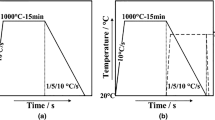Conclusions
-
1.
High temperature thermomechanical treatment of medium carbon structural steels subjected to plastic deformation by torsion during this treatment results in the best mechanical properties, the highest corrosion resistance and the highest corrosion fatigue resistance when the degree of deformation during the treatment is of a given value. This degree of plastic deformation during thermomechanical treatment is not constant and depends on the character and the conditions of tests. High degrees of plastic deformation should not be used during thermomechanical treatment because they induce intense recrystallization of the deformed austenite and also the precipitation of large amounts of products of nonmartensitic transformation during cooling.
-
2.
Changes in the heating rate between 5 and 30°/sec do not affect the mechanical properties. An increase of the heating rate to 200°/sec increases the strength and the ductility of the steel.
-
3.
The conclusions of some investigator who negate the role of fragmentation of martensite crystals in the strengthening of steel by thermomechanical treatment were confirmed by our investigations.
-
4.
The use of high temperature thermomechanical treatment is particularly effective when a steel with a martensite or troostite-martensite structure is subjected to low temperature tempering.
-
5.
High temperature thermomechanical treatment in which plastic deformation is induced by torsion is promising for shafts, bars, torsion bars, and other machine parts having the shape of solids of rotation.
Similar content being viewed by others
Literature cited
R. Toth and N. TASM, No. 1 (1962).
V. I. Pokhmurs'kii and G. V. Karpenko, Dopovidi AN UkrSSR, No. 12 (1963).
A. P. Gulyaev, Heat Treatment of Metals [in Russian], Mashgiz, Moscow (1955).
L. I. Kogan and R. I. Éntin, MiTOM, No. 1 (1962).
V. Zackay and W. Justusson, Spec. Rept. Iron and Steel Inst., No. 76 (1962).
A. V. Nekrasov, Text of General Chemistry [in Russian], Goskhimizdat (1954).
A. P. Gulyaev, Heat Treatment of Steel [in Russian], Mashgiz, Moscow (1960).
G. V. Akimov, Theory and Methods of Investigation of Corrosion of Metals [in Russian], Izd. AN USSR (1945).
A. V. Ryabchenkov, Corrosion Fatigue Resistance of Steel [in Russian], Mashgiz (1953).
Author information
Authors and Affiliations
Additional information
Translated from Metallovedenie i Termicheskaya Obrabotka Metallov, No. 2, pp. 29–35, February, 1965.
Rights and permissions
About this article
Cite this article
Pokhmurskii, V.I., Karpenko, G.V. Thermomechanical treatment of structural carbon steel. Met Sci Heat Treat 7, 99–104 (1965). https://doi.org/10.1007/BF00655813
Issue Date:
DOI: https://doi.org/10.1007/BF00655813




